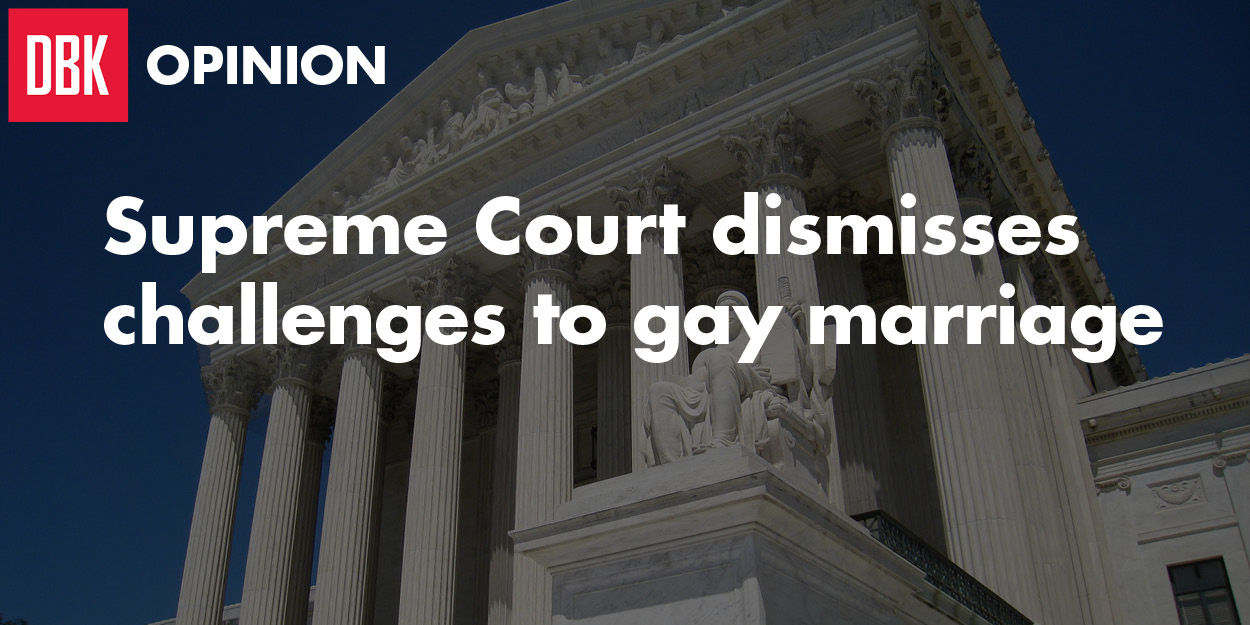
Gay marriage
After making two major rulings in June 2013 — striking down the Defense of Marriage Act and rejecting California’s same-sex marriage ban — the U.S. Supreme Court made a memorable move yesterday that furthered support for gay marriage: It did nothing.
An event that comes as a major surprise given the controversy of same-sex marriage bans throughout the country, the court decided to let appeals court rulings stand rather than provide legal opinions on them. This means that five states — Virginia, Oklahoma, Wisconsin, Indiana and Utah — can now allow gay marriages, given that their appellate court rulings in favor of these unions have been affirmed by the nation’s highest court.
Though this state was not involved in today’s Supreme Court decision — it legalized gay marriage by referendum in November 2012 — this decision indirectly affects the Washington Metropolitan area and students at this university.
Gay residents of our southern neighbor, Virginia, can now access marriage licenses, meaning the plethora of young college graduates and professionals who move to the Northern Virginia area will have similar marriage rights as those who stay in this state after graduation.
It’s no exaggeration to say that our generation has been instrumental in the fight for gay marriage for years. Among all age demographics, 18- to 29-year-olds have shown the strongest support for the cause throughout the past 18 years, according to Gallup. Not only have we been the most supportive, but we’ve shown the largest increase in support — from 41 percent in favor of legalizing gay marriage in 1996 to an astounding 78 percent this year.
Yesterday’s surprise should bring excitement to students at this university who may decide to move to a different state in the future or have loved ones in states that formerly banned gay marriage. Though this excitement should be welcomed, it doesn’t mean the fight for equality is over.
When actions are legalized, it’s easy to think the debate has ended. Gay marriage is now legal in 24 states and the District of Columbia, but the issue isn’t so binary: Just because more of these unions are legalized doesn’t mean our support for them should dwindle.
Legally, the Supreme Court has not placed a definitive, binding opinion on gay marriage in these states. In fact, the court did not explain its dismissal of gay marriage appellate cases in the states.
In the future, key constitutional questions concerning gay marriage might still appear before the court. With this in mind, we shouldn’t assume the Supreme Court’s silence on the issue equates to constitutional support for gay marriage.
We’ve never seen such a sudden change impacting so many people in the gay marriage fight until yesterday’s decision. As an generation that speaks out in support of gay rights, we should maintain a positive yet cautious attitude about this event.
Many of the states bordering this one have already legalized gay marriage, but some states to which we might have little connection — such as Louisiana, Texas, Wyoming and 23 others — have yet to allow it.
Just because we aren’t suffering from the same legal problems doesn’t mean we should ignore what’s happening in other corners of the country. This editorial board is excited about the progress the same-sex marriage movement has made, but we advise readers to be aware that the fight is long from over.
To those who support this cause, victories shouldn’t prevent us from moving forward. If anything, it should make us shift our legal focus on states that still need to change their policies on marriage. Perhaps one day gay marriage bans will only be a part of American history, but for now, our dedication to the movement should remain strong and unstoppable.



